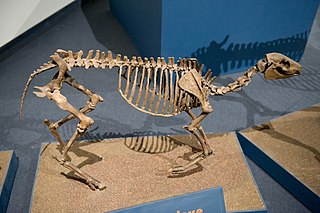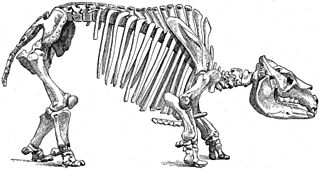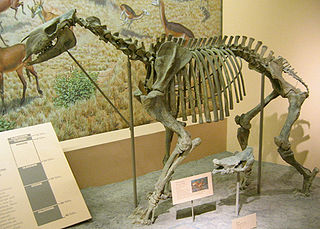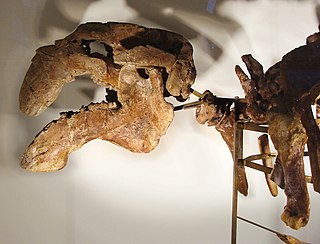
Leptictidium is an extinct genus of small mammals that were likely bipedal. Comprising eight species, they resembled today's bilbies, bandicoots, and elephant shrews, and occupied a similar niche. They are especially interesting for their combination of characteristics typical of primitive eutherians with highly specialized adaptations, such as powerful hind legs and a long tail which aided in locomotion. They were omnivorous, their diet a combination of insects, lizards, frogs, and small mammals. Leptictidium and other leptictids are not placentals, but are non-placental eutherians, although they are closely related to placental eutherians. They appeared in the Lower Eocene, a time of warm temperatures and high humidity, roughly fifty million years ago. Although they were widespread throughout Europe, they became extinct around thirty-five million years ago with no descendants, as they were adapted to live in forest ecosystems and were unable to adapt to the open plains of the Oligocene.

Miohippus is an extinct genus of horse existing longer than most Equidae. It lived in what is now North America from 32 to 25 million years ago, during the late Eocene to late Oligocene. According to the Florida Museum of Natural History, Othniel Charles Marsh first believed Miohippus lived during the Miocene and thus named the genus using this incorrect conclusion. More recent research provides evidence that Miohippus actually lived during the Paleogene period.

Mesonychia is an extinct taxon of small- to large-sized carnivorous ungulates related to artiodactyls. Mesonychians first appeared in the early Paleocene, went into a sharp decline at the end of the Eocene, and died out entirely when the last genus, Mongolestes, became extinct in the early Oligocene. In Asia, the record of their history suggests they grew gradually larger and more predatory over time, then shifted to scavenging and bone-crushing lifestyles before the group became extinct.

Notoungulata is an extinct order of ungulates that inhabited South America from the early Paleocene to the end of the Pleistocene, living from approximately 61 million to 11,000 years ago. Notoungulates were morphologically diverse, with forms resembling animals as disparate as rabbits and rhinoceroses. Notoungulata are the largest group of South American native ungulates, with over 150 genera in 14 families having been described, divided into two major subgroupings, Typotheria and Toxodontia. Notoungulates first diversified during the Eocene. Their diversity declined from the late Neogene onwards, with only the large toxodontids persisting until the end of the Pleistocene, perishing as part of the Late Pleistocene extinctions among with most other large mammals in the Americas. Collagen sequence analysis suggests that notoungulates are closely related to litopterns, another group of South American ungulates, and their closest living relatives being perissodactyls, including rhinoceroses, tapirs and equines as part of the clade Panperissodactyla. However their relationships to other South American ungulates are uncertain. Several groups of notoungulates separately evolved ever-growing cheek teeth.

Hyaenodon ("hyena-tooth") is an extinct genus of carnivorous placental mammals from extinct tribe Hyaenodontini within extinct subfamily Hyaenodontinae, that lived in Eurasia and North America from the middle Eocene, throughout the Oligocene, to the early Miocene.

Chalicotheriidae is an extinct family of herbivorous, odd-toed ungulate (perissodactyl) mammals that lived in North America, Eurasia, and Africa from the Middle Eocene until the Early Pleistocene, existing from 48.6 to 1.806 mya. They are often called chalicotheres, a term which is also applied to the broader grouping of Chalicotherioidea. They are noted for their unusual morphology compared to other ungulates, such as their elongated clawed forelimbs. They are thought to have been browsers.

Miacis is an extinct genus of placental mammals from clade Carnivoraformes, that lived in North America from the early to middle Eocene.

Merycoidodontoidea, previously known as "oreodonts" or "ruminating hogs," are an extinct superfamily of prehistoric cud-chewing artiodactyls with short faces and fang-like canine teeth. As their name implies, some of the better known forms were generally hog-like, and the group has traditionally been placed within the Suina, though some recent work suggests they may have been more closely related to camels. "Oreodont" means "mountain teeth," referring to the appearance of the molars. Most oreodonts were sheep-sized, though some genera grew to the size of cattle. They were heavy-bodied, with short four-toed hooves and comparatively long tails.

Machaeroides ("dagger-like") is an extinct genus of sabre-toothed predatory placental mammals from extinct subfamily Machaeroidinae within extinct family Oxyaenidae, that lived in North America (Wyoming) from the early to middle Eocene.

Patriofelis is an extinct genus of large, cat-like predatory placental mammals from extinct subfamily Oxyaeninae within extinct family Oxyaenidae, that lived in North America from the early to middle Eocene. It was around 1.2 to 1.8 metres long, not including the tail, and weighed about 40–90 kg, making it around the same size as a modern cougar. It had short legs with broad feet, suggesting that it may have been a poor runner, but a quite good swimmer. As its close relative Oxyaena was a reasonably good climber, it is possible Patriofelis could climb as well. It is found in particular in the Bridger Basin of southwestern Wyoming and at John Day Fossil Beds National Monument, Oregon, both in the United States.

Eotheroides is an extinct genus of Eocene sirenian. It is an early member of the family Dugongidae, which includes the extant dugong. Fossils have been found from Egypt, India, and Madagascar. Eotheroides was first described by Richard Owen in 1875 under the name Eotherium, which was replaced by the current name in 1899.

Didymictis is an extinct genus of placental mammals from extinct subfamily Didymictinae within extinct family Viverravidae, that lived in North America and Europe from the late Paleocene to middle Eocene.

Tillodontia is an extinct suborder of eutherian mammals known from the Early Paleocene to Late Eocene of China, the Late Paleocene to Middle Eocene of North America where they display their maximum species diversity, the Middle Eocene of Pakistan, and the Early Eocene of Europe. Leaving no descendants, they are most closely related to the pantodonts, another extinct group. The tillodonts were medium- to large-sized animals that probably feed on roots and tubers in temperate to subtropical habitats.

Leptictida is a possibly paraphyletic extinct order of eutherian mammals. Their classification is contentious: according to cladistic studies, they may be (distantly) related to Euarchontoglires, although they are more recently regarded as the first branch to split from basal eutherians. One recent large-scale cladistic analysis of eutherian mammals favored lepictidans as close to the placental crown-clade; and several other recent analyses that included data from Cretaceous non-eutherian mammals found Leptictis to belong to the superorder Afrotheria.

Epoicotheriidae is an extinct paraphyletic family of insectivorous placental mammals within extinct order Palaeanodonta, that lived in North America, Asia and Europe from the late Paleocene to early Oligocene. Epoicotheriids were fossorial mammals. Late Eocene/early Oligocene genera were highly specialized animals that were convergent with the talpids, golden moles and marsupial mole in the structure of their skulls and forelimbs, and would have had a similar lifestyle as subterranean burrowers.

Sinopa is an extinct genus of placental mammals from extinct family Sinopidae within extinct order Hyaenodonta, that lived in North America and Asia from the early to middle Eocene.
Megaleptictis is an extinct genus of large insectivore mammal from Late Paleogene deposits of Custer County, South Dakota. It is known from the holotype KUVP 2568 a nearly complete skull including the mandibles. It was collected in an 1894 University of Kansas expedition from the tan siltstone of the White River Group. It was first named by Tj Meehan and Larry D. Martin in 2011 and the type species is Megaleptictis altidens.

Agorophius is an extinct genus of toothed whale that lived during the Oligocene period, approximately 32 million years ago, in the waters off what is now South Carolina.

Gypsonictops is an extinct genus of leptictidan mammals of the family Gypsonictopidae, which was described in 1927 by George Gaylord Simpson. Species in this genus were small mammals and the first representatives of the order Leptictida, that appeared during the Upper Cretaceous.

Epoicotheriinae is an extinct paraphyletic subfamily of insectivorous placental mammals within extinct paraphyletic family Epoicotheriidae in extinct order Palaeanodonta, that lived in North America and Europe from the early Eocene to early Oligocene. Epoicotheriins were fossorial mammals. Late Eocene/early Oligocene genera were highly specialized animals that were convergent with the talpids, golden moles and marsupial mole in the structure of their skulls and forelimbs, and would have had a similar lifestyle as subterranean burrowers.






















